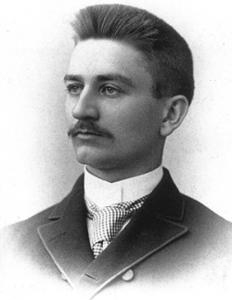
Herbert Henry Dow (1864-1930)
On February 26, 1866, American chemical industrialist Herbert Henry Dow was born. Dow best known as the founder of the American multinational conglomerate Dow Chemical. He also was a prolific inventor of chemical processes, compounds, and products, and was a successful businessman.
Herbert Henry Dow – Early Years
Herbert Henry Dow was born in Belleville, Ontario, Canada, the eldest child of Americans Joseph Henry Dow, an inventor and mechanical engineer, and his wife, Sarah Bunnell. Soon after his birth the family moved back to the U.S. and again in 1878 to Cleveland, Ohio to follow Joseph’s job with the Derby Shovel Manufacturing Company. Dow inherited his father’s knack for mechanics and invention, and devised an early prototype of a chicken egg incubator when the family was still living in Connecticut.[2] After graduating from high school in 1884, Dow enrolled in the Case School of Applied Science (now Case Western Reserve University). He began specialized research into the chemical composition of brines in Ohio and nearby areas, by which he discovered that brine samples from Canton, Ohio and Midland, Michigan were very rich in bromine, which at the time was a primary ingredient in medicines and was widely used in the fledgeling photographic industry. Following his graduation as B.S. from Case in 1888, Dow worked for a year as a chemistry professor at Huron Street Hospital College in Cleveland, while continuing his research into the extraction of chemicals from brine. Brines contained bromine, which in Dow’s childhood was used to make sedative medications, and later new applications were discovered for its use in the nascent photographic film-developing industry.[2]
Receiving the First Patent
In 1889 Herbert Henry Dow received his first patent after inventing a more cost-effective and streamlined process for bromine extraction. He quickly formed his own company, but was bankrupt within the year. His associates were impressed with his work and in 1890 helped him to found the Midland Chemical Company in Midland, Michigan. Dow continued his work extracting bromine, and by early 1891 he had invented the Dow process, a method of bromine extraction using electrolysis to oxidize bromide to bromine.
Expanding Research on Electrolysis
Dow wanted to expand his research of electrolysis to yield other chemicals. However, his financial backers did not approve of his continued research and fired him from the Midland Chemical Company. Nevertheless, he continued his research, developing a process to extract chloride and caustic soda from sodium chloride. Chloride was also used to make chlorine, another potentially lucrative product for the industrial and consumer markets.[2] After seeking funding from potential backers in Cleveland, including family friends and former Case School of Applied Science classmates, Dow moved to Ohio and founded the Dow Process Company in 1895 to develop the production mechanism for his process. The following year he returned to Midland, where he formed the Dow Chemical Company as successor to the Dow Process Company. Dow’s chlorine products found application in insecticides and (through the electrolysis of magnesium chloride) stucco and magnesium metal.[1]
Dow Chemical Company
With his new company and new technology, Dow produced bromine very cheaply. At the time, the German government supported a bromine cartel, Bromkonvention, which had a near-monopoly on the supply of bromine. The Germans had made it clear that they would dump the market with cheap bromine if Dow attempted to sell his product abroad. In 1904 Dow defied the cartel by beginning to export his bromine at its cheaper price to England. Dow continued exporting to England and Japan. The German cartel retaliated by dumping the US market with bromine in an effort to put him out of business. Unable to compete with this predatory pricing in the U.S., Dow instructed his agents to buy up hundreds of thousands of pounds of the German bromine locally at the low price. The Dow company repackaged the bromine and exported it to Europe, selling it even to German companies with a reasonable profit. Dow began to reap enormous profits from the ruse, which went undiscovered by the Bromkonvention for some time.[2] The cartel, having expected Dow to go out of business, was unable to comprehend what was driving the enormous demand for bromine in the U.S., and where all the cheap imported bromine dumping their market was coming from. Thus, they continued to slash prices on their bromine in the U.S., but finally caught on to Dow’s tactic and realized that they could not keep selling below cost, they then increased their prices worldwide.
The World’s Leading Chemical Manufacturer
Dow further introduced automatic processing to produce magnesium sulfate (Epsom salts) from ocean brines, produced the first synthetic indigo process in the Western Hemisphere (1916), and was the first American producer of iodine (which he also extracted from brine). He eventually was granted some 65 patents as his company became one of the world’s leading chemical manufacturers.[1]
World War I
World War I provided demand that enabled its growth, because Britain blockaded the ports of Germany, which at the time included most of the world’s largest chemical suppliers. Dow Chemical quickly moved to fill the gap for wartime goods, producing magnesium for incendiary flares, monochlorobenzene and phenol for explosives, and bromine for medicines and tear gas. By 1918, 90% of the Dow Chemical Company production was in support of the war effort. After World War I, Dow guided his company into an ever-expanding array of processes and products.[2] He discovered that it could be used to make automobile pistons. The new pistons proved to give more speed and better fuel efficiency. The Dowmetal pistons were used heavily in racing vehicles.
Death and Legacy
Herbert Henry Dow died on October 15, 1930 from cirrhosis of the liver, aged 64. Three years after his death, his company opened its first seawater-processing plant in North Carolina. By World War II, Dow plants on the Gulf Coast were in a position to supply magnesium for firebombs and to make lightweight parts for airplanes.[3]
H. S. Ray, Mod-01 Lec-01 Lecture-01-Extraction of Copper (Contd.), [6]
References and Further Reading:
- [1] Herbert H. Dow, American Chemist, at Britannica Online
- [2] “Dow, Herbert H..” Encyclopedia of World Biography. . Encyclopedia.com
- [3] Herbert Henry Dow, Chemical Heritage Foundation
- [4] Herbert H. Dow at Wikidata
- [5] Herbert H. Dow at Reasonator
- [6] H. S. Ray, Mod-01 Lec-01 Lecture-01-Extraction of Copper (Contd.), nptelhrd @ youtube
- [7] Whitehead, Don (1968). The Dow Story: The History of the Dow Chemical Company (1st ed.). McGraw-Hill Book Co. pp. 24, 37–38.
- [8] Timeline of Canadian Inventors, via DBpedia and Wikidata






Pingback: Whewell’s Gazette: Year 3, Vol. #29 | Whewell's Ghost